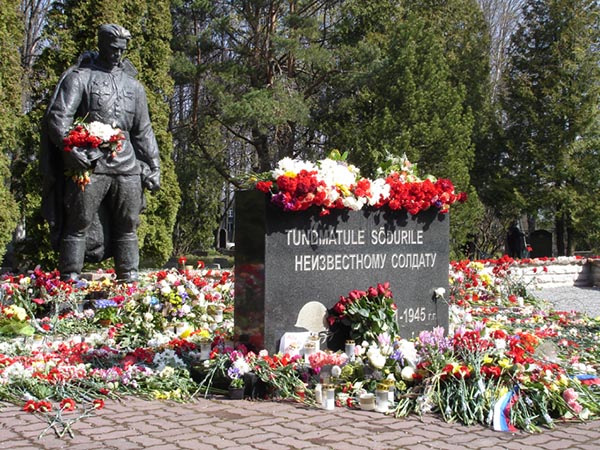We are accustomed to think of the “cloud” as a place-less, formless mass of data floating “out there.” It has even been argued that new computer technologies and the movement of companies’ data “to the cloud” might so transform our inherited notions of time, space, and power that it could mean the end of history, geography, and power.[1] The case of “e-Estonia,” however, challenges this notion: Estonia is a country which, unlike people and companies going “to the cloud,” hopes to actually move itself “into the cloud,” with profound implications for how we understand both the cloud metaphor and geopolitics in the digital age.

Clouds above a swamp boardwalk in Tuhu, Estonia. Copyright Rene Jakobson, some rights reserved. https://www.flickr.com/photos/renej/3947241936
e-Estonia
Estonia is a small former Soviet Republic in northern Europe, with a territory of only 45 thousand square kilometers and population of just 1.3 million. Since the collapse of the Soviet Union in 1991, it has made a number of moves towards building a digital state, or, as it is often referred to, an “e-Estonia.” As a Research Fellow with the Centre for Science and Technology Studies of the European University at St. Petersburg, I have been studying how with e-Estonia the “the cloud” actually becomes a new type of space, the contours of which affect other concrete spaces and feed into a new type of nation-building project.
In 1999 Estonia started an “e-Government.” Even before that, in 1996, the Tiger Leap Foundation was launched, with the goals of adjusting the educational system to the needs of a quickly-developing information society and providing schools with modern information and communication technology. Along with e-government, the country started developing and offering internet banking services; gradually it has all evolved to a “digital society,” with an integrated set of component e-services such as Digital Signature, e-Law, i-Voting, e-Tax, e-Prescription, and many others (follow this link for more on e-Estonia).

Bronze Soldier memorial, Tallinn. Copyright Jens-Olaf Walter, some rights reserved. https://www.flickr.com/photos/65817306@N00/482571055/sizes/o/
This has not been without conflict, however. In 2007, a controversial decision of the Estonian government to move the Bronze Soldier, a Soviet World War II memorial, from the center of Tallinn to the outskirts of the city was followed by protests started by the Russian-speaking minority, which led to the riots known as the Bronze Night. Immediately following these riots, the country experienced a series of DoS attacks which brought down the banking and e-government systems. The cyber-attacks were branded as having been performed by Russian hackers, and Estonian authorities treated the event as a wake-up call to invest heavily in the development of cyber security measures. Shortly after the attacks, a NATO cyber think tank was placed in Estonia, contributing to the image of Estonia as the ultimate cyber frontier between Europe and Russia. This could be seen as the first instance of laying out a new geographical and political landscape through the inclusion of the digital, which later on will be echoed in the “cloud” case.
The geographical location of Estonia has been crucial in building a new national identity. In 1999, Samuel P. Huntington’s The Clash of Civilizations and the Remaking of World Order was translated into Estonian. The translation featured a foreword by Estonia’s then-Minister of Foreign Affairs and now-President Toomas Hendrik Ilves. On the occasion of presenting the translation, Huntington visited Estonia and spoke at a conference together with Ilves and Estonia’s Prime Minister Mart Laar. The thesis of the book, according to which the borderline between the Western and Orthodox “civilizations” goes exactly along the Narva river of Estonia, resonated with elite efforts to position the country as the borderline state between the West and Russia.[2] As President Lennart Meri put it in his 1994 Independence Day address: “Our border is the border of European values.”[3]
Estonia goes into the cloud
When companies and people are said to be “going to the cloud,” careful observers should recognize that they are expressing something essentially contradictory: the hard materiality of actual data transfers combines with the wispy metaphor of the cloud in the imagination of these digital pioneers. This imagination, however, drives both important myths and serves as the bedrock for real conceptual and practical shifts. Estonia, however, imagines the cloud somewhat differently: the country of Estonia is actually talking about “going into the cloud.” Here, “the cloud” is seen not so much as a repository for data, but as a conceptual and literal space, to which the whole country is transferring.
In 2014, the ideas of “a country without a territory” or “a state functioning from the cloud” began to circulate widely within the local media. The idea came about while drafting the Estonian Digital Society Strategy 2020; Ilves, now president, wanted to say something dramatic, which would attract international attention. As Taavi Kotka, the country’s CIO, recalled: “[Ilves] read the draft of the strategy and said it lacked ambition. I then added this revolutionary idea to the document’s foreword and asked ‘Is it ambitious enough now, Mr. President?’”[4]
In e-Estonia’s technology discourse, the imaginary and the real become intertwined in a complex interplay. In the government’s media-friendly rhetoric, there is a strong idea of a country that, sublimely, will exist and function in a new, technologically-boosted reality. However, as Kotka himself explains, what the idea actually boils down to in practice is essentially simply putting servers in embassies on the territories of friendly countries.[5] Estonia keeps a number of vital registries in digital form (as do other countries, I imagine). To secure the safety of these registries, they will keep copies of them in their embassies; however, existing brick and mortar embassies are not equipped with facilities for preserving large data. As the data should be kept on Estonian territory, however, the idea of digital embassies has emerged as one potential solution.
The cloud narrative of digital Estonia is inherently connected with a surprising narrative of cyber security: the “cloud” is presented as a safe haven to which the country will have the opportunity to escape in case something goes wrong in its real, physical territory. As Taavi Kotka explains, by going “into the cloud” the country is ostensibly going to protect itself from potential physical threats. Making reference to events that occurred in Georgia in 2008, Russia is implied as a potential aggressor:
Should Estonia become a target of a massive cyber-attack, it would be much more difficult to ‘switch us off’ as a state than, for example, [it was with] Georgia in August 2008. The state would be able to provide e-services from Germany, Sweden or Holland.[6]
Building upon a national history of exile and displacement, the “cloud” is imagined as a space that, even under dire circumstances, would allow the normal functioning of the state: “Estonians could live in Finland or London, be deported to Siberia or whatever: we could still elect our parliament, collect taxes, etc.”[7]
Moreover, for the state, the sublime power of technology to reshape space is seen by some as a first step to immortality. As one Estonian entrepreneur writes on his blog:
It [cloud technology for the state] basically means that a country could become immortal. It is like our way of saying “screw you Russia!”… or Germany, Denmark, Sweden (the countries that have occupied Estonia in the past) or others that might be interested. A psychologist could say that this is our way to deal with the history of 750 years of slavery and is thus our unconscious fear of losing our freedom again – immortality being the ultimate manifestation of freedom.[8]
The Estonian “cloud,” then, is conceptually different from other “clouds”: countries usually promote themselves as places for building data centers for cloud storage, emphasizing their territory as ideal for these sorts of “clouds” (weather and temperature conditions, reliable power supplies). Estonia, however, argues that it doesn’t need a territory at all to be the state, insisting upon its ability to exist “in the cloud.” Estonia’s plans for “going into the cloud” are a unique case of a country using technology to reimagine itself. In a striking articulation of the physical and the virtual, the digital imaginary made possible by cloud technology allows for the creation of a new space for the state.
[1] For more on this, see Mosco, V., 2014. To the Cloud: Big Data in a Turbulent World, Boulder, CO: Paradigm Publishers and Mosco, V. 2004. The Digital Sublime. MIT Press.
[2] For more on this, see Kuus, M., 2012. “Banal Huntingtonianism: civilizational geopolitics in Estonia,” in Guzzini, S. (ed) The Return of Geopolitics in Europe? Social Mechanisms and Foreign Policy Identity Crises. Series: Cambridge Studies in International Relations (No. 124).
[3] Lagerspetz, Mikko. 1999. “Postsocialism as a Return: Notes on a Discursive Strategy.” East European Politics and Societies 13 (2): 377–390.
[4] Retrieved from http://issuu.com/eas-estonia/docs/lie_spring_2014_issuu/17
[5] Ibid.
[6] Ibid.
[7] Ibid.
[8] Retrieved from http://www.ehasoo.com/where-estonia-is-heading-is-immortality-possible-for-a-country/.

1 Trackback